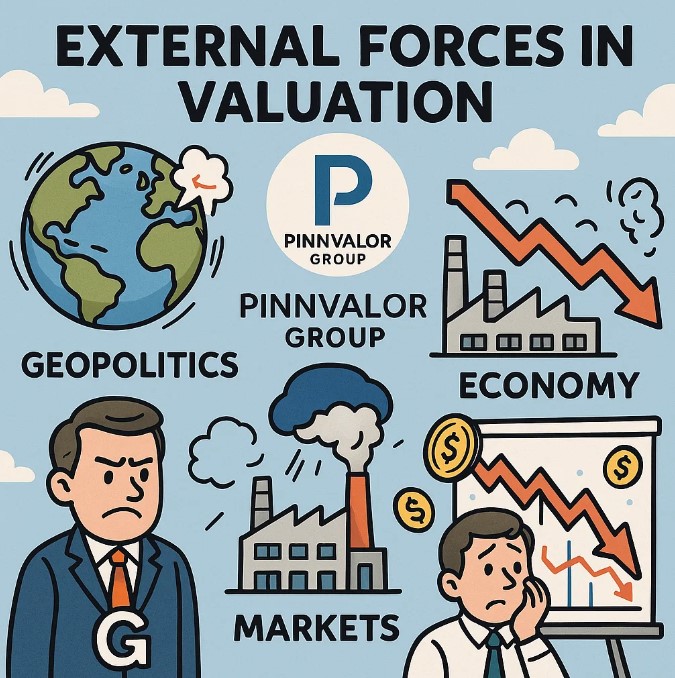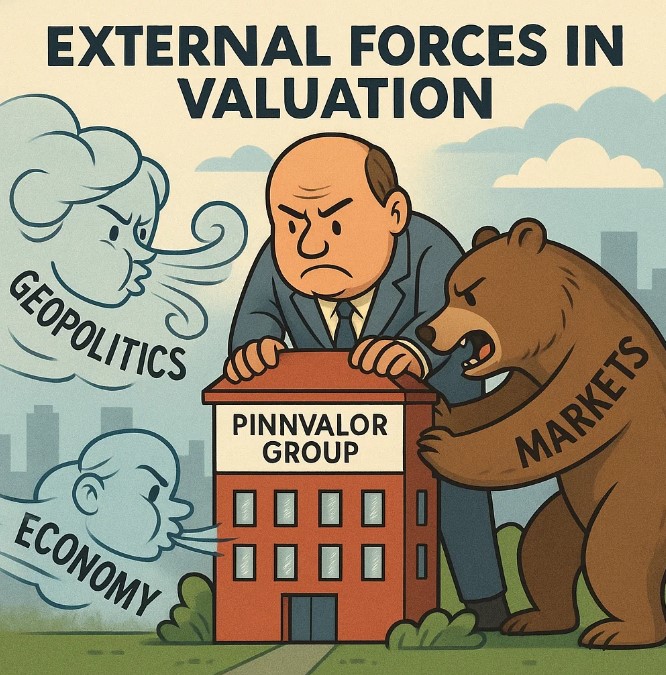
External Forces in Valuation: Geopolitics, Economy & Markets
Valuation is often seen as a quantitative exercise—an objective assessment of an entity’s worth using established models like discounted cash flows (DCF), comparable company analysis, or asset-based approaches. However, these models don’t operate in a vacuum. They are influenced—often profoundly—by external factors that may lie outside the direct control of the company or investor. Among these, geopolitical risks, economic shifts, and market dynamics are the most impactful.
How do unseen global forces silently reshape the true value of your business?
Great investors don’t just analyze numbers—they decode the world around them. Because value is shaped as much by geopolitics and markets as by profit margins.
In this blog, we will examine how each of these forces plays a pivotal role in shaping valuations and how decision-makers can better account for them.
1. Geopolitical Risks: The Price of Uncertainty
Geopolitical events—ranging from wars and territorial disputes to trade wars and diplomatic breakdowns—can rapidly and materially impact valuations.
Key Influences:- Risk Premium Adjustment: Investors typically demand higher returns (and thus apply lower valuation multiples) when geopolitical risks rise.
- Supply Chain Disruptions: Political instability or sanctions can interrupt supply chains, inflate costs, or limit market access.
- Regulatory and Policy Uncertainty: Changing foreign investment laws, tariffs, or nationalization threats can devalue assets almost overnight.
The Russia-Ukraine conflict in 2022 had wide-ranging valuation impacts across energy, defense, and agricultural sectors. Companies reliant on Russian gas or Ukrainian wheat saw increased risk premiums, while defense contractors experienced valuation uplifts due to anticipated increases in military spending.
Strategic Consideration:Valuation models must incorporate scenario analysis to test outcomes under different geopolitical conditions, helping businesses and investors prepare for uncertainty.
2. Economic Shifts: The Macroeconomic Framework
Macroeconomic conditions form the backbone of many valuation inputs. Whether a business is thriving in a high-growth environment or bracing for recession, the economic climate alters expectations for revenue, costs, and risk.
Key Influences:- Interest Rates: A rise in interest rates leads to higher discount rates in DCF models, lowering present values of future cash flows.
- Inflation: It affects both cost structures and consumer demand. High inflation can reduce real profitability, especially in sectors with limited pricing power.
- Exchange Rates: For businesses with cross-border operations, currency fluctuations impact both revenues and asset values.
In the wake of COVID-19, economies saw historically low interest rates, which pushed equity valuations higher—especially in tech. However, the post-pandemic inflation surge and subsequent interest rate hikes caused dramatic corrections in those same sectors.
Strategic Consideration:Valuation approaches should be regularly updated with macroeconomic forecasts, incorporating real-time data on GDP growth, inflation, and central bank policies.
3. Market Dynamics: Sentiment, Cycles, and Competition
Markets are more than cold data—they are also driven by perception, expectations, and emotional responses. These market dynamics can sometimes distort valuations in both positive and negative directions.
Key Influences:- Market Sentiment: Over-optimism or fear can lead to overvaluation (bubbles) or undervaluation (panic-driven selloffs).
- Industry Cycles: Different sectors go through their own economic cycles. For instance, real estate and commodities are heavily influenced by interest rate movements and global demand.
- Innovation & Disruption: New technologies or business models can shift competitive dynamics, rendering older valuation assumptions obsolete.
The AI boom of 2023–2025 led to surging valuations of companies involved in semiconductors, cloud computing, and large language models—even when many of these firms had limited earnings. Conversely, traditional industries like print media or legacy IT services saw declining valuations amid perceived obsolescence.
Strategic Consideration:Investors must separate fundamentals from hype and use relative valuation techniques to understand whether current market prices reflect intrinsic value or speculation.

Integrating External Forces into Valuation Models
To make valuations more robust in the face of external volatility, consider these techniques:
- Scenario Analysis & Sensitivity Testing: Model best-case, worst-case, and base-case assumptions based on different geopolitical and economic outcomes.
- Risk-Adjusted Discount Rates: Increase the discount rate in the presence of heightened external risk to reflect the true cost of capital.
- Real Options Valuation: This method recognizes flexibility under uncertainty—for example, the option to delay investment during turbulent times.
- Qualitative Adjustments: Beyond the numbers, consider incorporating qualitative assessments of regulatory risk, competitive threats, and reputational issues.
Conclusion: A Multi-Dimensional Approach to Valuation
Valuation is not just about projecting cash flows and applying multiples—it’s about context. And that context is shaped by powerful external forces.
- Geopolitical risks inject volatility and alter investor perceptions of safety.
- Economic shifts change the financial assumptions underlying valuation models.
- Market dynamics add a layer of behavioral influence that can either inflate or suppress value.
In today’s volatile world, the most accurate and insightful valuations come from those who can look beyond the spreadsheet and see the bigger picture.
